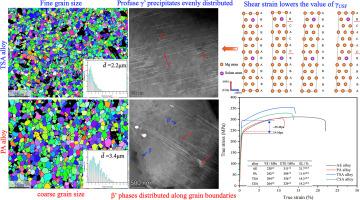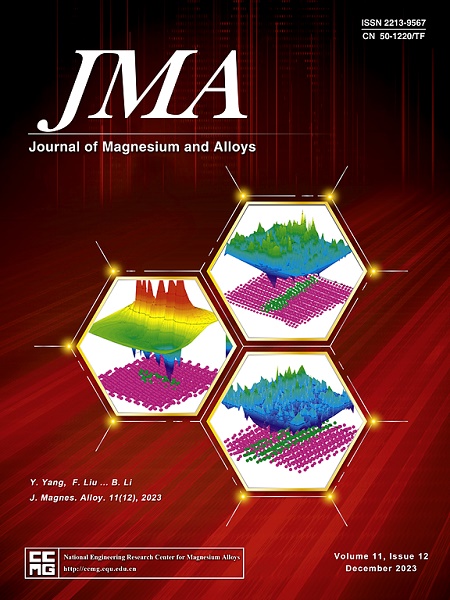通过应力时效策略调节沉淀行为,实现 Mg-1.1Gd-0.6Zn-0.3Mn 合金的强度-电导率协同效应
IF 13.8
1区 材料科学
Q1 METALLURGY & METALLURGICAL ENGINEERING
引用次数: 0
摘要
调节镁合金的沉淀行为以克服强度-电导率权衡难题,是材料界长期以来一直在思考的问题。为此,最近有人在老化过程中施加外应力,结果表明外应力在影响原子扩散和调节相界相干性方面具有巨大潜力。本研究对 Mg-1.1Gd-0.6Zn-0.3Mn 合金进行了弹性拉伸(TSA)和压缩应力时效(CSA),并研究了应力时效过程中多种析出物之间的竞争。在传统的峰值时效合金中,大量的β'析出物主要沿晶界分布。而在 TSA 和 CSA 合金中析出的是高密度的 γ'相,而不是 β'相。第一原理计算显示,施加外应力会引入剪切应变,从而降低不稳定的堆积断层能,从而促进γ'相的析出,阻碍β'相的析出。此外,由于相边界释放了弹性局部应变,CSA 样品中出现了从γ'相到长周期堆积有序相(LPSO)的连续转变。经过 TSA 处理后,样品的极限拉伸强度达到 356 兆帕,屈服强度为 294 兆帕,总伸长率为 14.3%。TSA 样品优异的强度-电导率协同作用主要是由于在拉伸变形过程中,大量γ'沉淀阻碍了大量金字塔形〈c + a〉位错的运动。这项研究为通过施加外应力调节含有多种类型析出物的镁合金的析出行为提供了新的见解,并拓展了在时效硬化镁合金中获得优异强度-电导率协同作用的潜在窗口。本文章由计算机程序翻译,如有差异,请以英文原文为准。


Achieving strength-ductility synergy in Mg-1.1Gd-0.6Zn-0.3Mn alloy by regulating precipitation behavior via stress aging strategy
Regulating the precipitation behavior of Mg alloys to overcome the strength-ductility trade-off puzzle is a long-thought pursuit in the materials community. With this purpose, external stress has been recently applied during aging and shows immense potential in affecting atomic diffusion, and regulating the coherence of the phase boundaries. In this study, elastic tensile (TSA) and compressive stress aging (CSA) of Mg-1.1Gd-0.6Zn-0.3Mn alloy are carried out and the competition of precipitation between multiple precipitates occurs during stress aging. A significant quantity of β’ precipitates primarily distribute along grain boundaries in conventional peak aging alloy. Whereas high density of γ’ phases rather than β’ phase precipitate in both TSA and CSA alloys. The first-principle calculations reveal that the application of external stress introduces shear strain, which decreases unstable stacking fault energies, and thereby promoting the precipitation of γ’ phase and impeding the precipitation of β’ phase. Furthermore, the sequential transformation from γ’ phase to Long Period Stacking Ordered (LPSO) phase occurs in CSA sample, due to the release of elastic local strain at phase boundaries. After subjected to TSA treatment, the sample possesses an ultimate tensile strength of 356 MPa, a yield strength of 294 MPa, and a total elongation of ∼14.3%. The excellent strength-ductility synergy of TSA sample is primarily contributed to the profuse γ’ precipitates hindering the motion of large number of pyramidal 〈c + a〉 dislocations during tensile deformation. This study offers new insights on regulating the precipitation behavior of Mg alloys containing multiple types of precipitates through the application of external stress, and extends the potential window for obtaining an excellent strength-ductility synergy in age-hardenable Mg alloys.
求助全文
通过发布文献求助,成功后即可免费获取论文全文。
去求助
来源期刊

Journal of Magnesium and Alloys
Engineering-Mechanics of Materials
CiteScore
20.20
自引率
14.80%
发文量
52
审稿时长
59 days
期刊介绍:
The Journal of Magnesium and Alloys serves as a global platform for both theoretical and experimental studies in magnesium science and engineering. It welcomes submissions investigating various scientific and engineering factors impacting the metallurgy, processing, microstructure, properties, and applications of magnesium and alloys. The journal covers all aspects of magnesium and alloy research, including raw materials, alloy casting, extrusion and deformation, corrosion and surface treatment, joining and machining, simulation and modeling, microstructure evolution and mechanical properties, new alloy development, magnesium-based composites, bio-materials and energy materials, applications, and recycling.
 求助内容:
求助内容: 应助结果提醒方式:
应助结果提醒方式:


